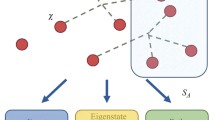Abstract
Entanglement has emerged as an important tool for understanding the properties of interacting quantum systems, but experimental measurements have been made only to a limited extent. It has been proposed that the entanglement entropy of free particles is closely related to particle number fluctuations that are more readily accessible experimentally. We study the relation between entanglement entropy and particle number fluctuations in interacting fermion systems. By using a self-consistent Hartree–Fock approximation, we find that entanglement entropy and particle number fluctuations have a linear relation with a well-defined proportionality coefficient even for interacting systems. Furthermore, the relation holds in the presence of random potentials. This strongly suggests that entanglement, like other physical properties such as particle number fluctuations, is governed by the correlation length.





Similar content being viewed by others
References
L. Amico, R. Fazio, A. Osterloh, V. Vedral, Rev. Mod. Phys. 80, 517 (2008)
P. Calebrese, J. Cardy, B. Doyon, J. Phys. A Math. Theor. 42, 500301 (2009)
N. Laflorencie, Phys. Rep. 643, 1 (2016)
A.J. Daley, H. Pichler, J. Schachenmayer, P. Zoller, Phys. Rev. Lett. 109, 020505 (2012)
R. Islam, R. Ma, P.M. Preiss, M.E. Tai, A. Lukin, M. Rispoli, M. Greiner, Nature (London) 528, 77 (2015)
I. Klich, G. Refael, A. Silva, Phys. Rev. A 74, 032306 (2006)
I. Klich, L.S. Levitov, Phys. Rev. Lett. 102, 100502 (2009)
H.F. Song, C. Flindt, S. Rachel, I. Klich, K. Le Hur, Phys. Rev. B 83, 161408(R) (2011)
H.F. Song, S. Rachel, C. Flindt, I. Klich, N. Laflorencie, K. Le Hur, Phys. Rev. B 85, 035409 (2012)
P. Calabrese, M. Mintchev, E. Vicari, Europhys. Lett. 98, 20003 (2012)
M.-C. Chung, I. Peschel, Phys. Rev. B 64, 064412 (2001)
I. Peschel, J. Phys. A Math. Gen. 36, L205 (2003)
S.-A. Cheong, C.L. Henley, Phys. Rev. B 69, 075111 (2004)
P. Calabrese, J. Cardy, J. Stat. Mech. 0406, P06002 (2004)
P. Calabrese, J. CardyJ, Phys. A Math. Theor. 42, 504005 (2009)
T. Giamarchi, H.J. Schulz, Phys. Rev. B 37, 325 (1988)
M.P.A. Fisher, P.B. Weichman, G. Grinstein, D.S. Fisher, Phys. Rev. B 40, 546 (1989)
Acknowledgements
This work was supported by the Basic Science Research Program through the National Research Foundation of Korea funded by the Ministry of Education, Science and Technology (Grant No. NRF-2019R1F1A1062704).
Author information
Authors and Affiliations
Corresponding author
Additional information
Publisher's Note
Springer Nature remains neutral with regard to jurisdictional claims in published maps and institutional affiliations.
Rights and permissions
Springer Nature or its licensor (e.g. a society or other partner) holds exclusive rights to this article under a publishing agreement with the author(s) or other rightsholder(s); author self-archiving of the accepted manuscript version of this article is solely governed by the terms of such publishing agreement and applicable law.
About this article
Cite this article
Kwon, H.B., Cha, MC. Relation of entanglement entropy and particle number fluctuations in one-dimensional Hubbard model. J. Korean Phys. Soc. 82, 194–198 (2023). https://doi.org/10.1007/s40042-022-00690-w
Received:
Revised:
Accepted:
Published:
Issue Date:
DOI: https://doi.org/10.1007/s40042-022-00690-w




